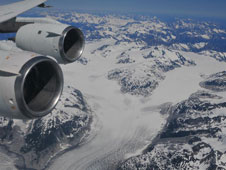- NASA Home
- > Centers
- > Dryden Home
- > Aircraft
- > DC-8
Dryden Aircraft
Text Size
DC-8 Airborne Science Laboratory
03.28.12
 DC-8 ASCENDS II Mission - This spectacular view of a large glacier in British Columbia, Canada, was captured from NASA's DC-8 flying laboratory during one of the ASCENDS II atmospheric sampling instrument validation flights. July 2011 (NSERC / Emily Schaller)
NASA's Airborne Science Program and the National Suborbital Education and Research Center (NSERC) at the University of North Dakota jointly manage science operations of NASA’s DC-8 Airborne Science Laboratory aircraft. Based at NASA's Dryden Aircraft Operations Facility, Palmdale, CA, the unique flying laboratory collects data for experiments in support of scientific projects serving the world's scientific community, including investigators from NASA and other federal, state, academic, and foreign institutions. The DC-8 flies three primary missions -- sensor development, satellite sensor verification, and basic research studies of the Earth's surface and atmosphere.
DC-8 ASCENDS II Mission - This spectacular view of a large glacier in British Columbia, Canada, was captured from NASA's DC-8 flying laboratory during one of the ASCENDS II atmospheric sampling instrument validation flights. July 2011 (NSERC / Emily Schaller)
NASA's Airborne Science Program and the National Suborbital Education and Research Center (NSERC) at the University of North Dakota jointly manage science operations of NASA’s DC-8 Airborne Science Laboratory aircraft. Based at NASA's Dryden Aircraft Operations Facility, Palmdale, CA, the unique flying laboratory collects data for experiments in support of scientific projects serving the world's scientific community, including investigators from NASA and other federal, state, academic, and foreign institutions. The DC-8 flies three primary missions -- sensor development, satellite sensor verification, and basic research studies of the Earth's surface and atmosphere.Data gathered by the DC-8 at flight altitude and by remote sensing have been used for scientific studies in archeology, ecology, geography, hydrology, meteorology, oceanography, volcanology, atmospheric chemistry, soil science, and biology.
Those interested in the DC-8's capability to accommodate instruments are encouraged to consult the 'DC-8 Experimenter's Handbook' (see below). The DC-8 is one of several aircraft based at the NASA Dryden Aircraft Operations Facility that support NASA's Airborne Science Program
DC-8 Science-Specific Capabilities:
NASA's DC-8 Airborne Science Laboratory, a -72 version of the four-engine first-generation jetliner, was acquired in 1985 and highly modified to support its airborne science mission. The aircraft has a range of 5,400 nautical miles (6,200 statute miles) and can fly at mission altitudes from 1,000 to 42,000 feet for up to 12 hours, although most science missions average 6 to 10 hours. The DC-8 can carry 30,000 pounds of scientific instruments and equipment.
The aircraft has many modifications specifically oriented to support scientific research. These include zenith and nadir instrument ports; modified window ports for instrument and probe mounting; external antenna mounts; wing pylon instrument mounts; optical windows of various materials; a dropsonde delivery tube; air and aerosol sampling probes; standard 19-inch equipment racks (up to 20 racks and 25 instruments typically accommodated); a laser chiller unit; both 400 Hz and 60 Hz power available to experimenter stations; and seating for up to 45 experimenters and flight crew.
The DC-8 flying laboratory also incorporates a suite of operational aircraft and data systems that can be tailored to specific missions or science instruments. These include weather radar; global positioning and inertial navigational systems; a radar altimeter; sensors for recording total air temperature, ambient pressure, and relative humidity; a time code generator (NTP and IRIG-B), video, and digital recording systems; data acquisition, distribution, and recording systems; an Ethernet LAN with servers; and Web-based displays.
The DC-8 also has Iridium and Inmarsat satellite communications capability. Two Iridium-based communications systems, one for flight crew communications and one for science team communications, a multichannel system for upload of meteorological data, chat messaging, limited data telemetry, and live Web page updates are available.
Point of Contact:
Frank Cutler
(661) 276-3998
Frank.W.Cutler@nasa.gov
For more on the National Suborbital Education and Research Center (NSERC), visit: http://www.nserc.und.edu
For more information on NASA's Airborne Science Program, visit: http://airbornescience.nasa.gov